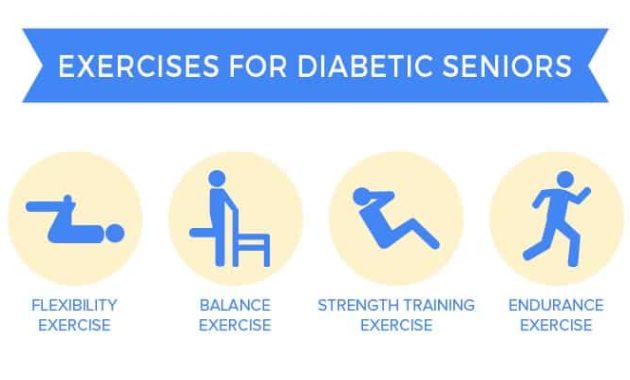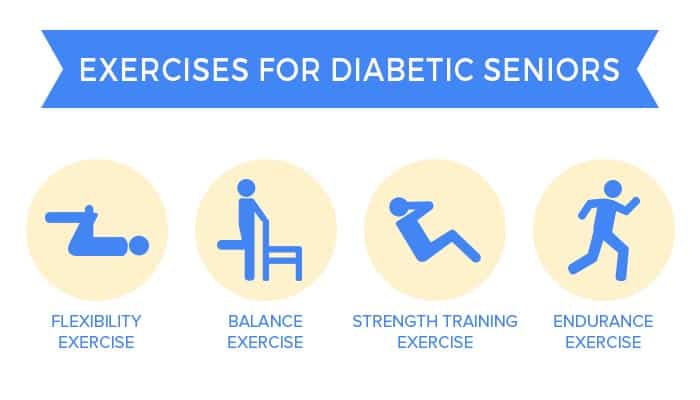
Simple Exercises for Diabetics: A Comprehensive Guide for All Fitness Levels
Living with diabetes requires proactive management. Exercise plays a vital role in this. It helps control blood sugar levels. It also improves overall health. This guide offers simple exercises. They are suitable for individuals with diabetes. They cater to all fitness levels. We will explore the benefits of exercise. We will also provide practical exercise routines. These routines are safe and effective. They are designed to fit your lifestyle.
This information is for educational purposes only. It is not a substitute for professional medical advice. Always consult your doctor before starting any new exercise program. This is especially crucial if you have diabetes. Your doctor can assess your health. They can also provide personalized recommendations. These recommendations are based on your individual needs.
The Benefits of Exercise for Diabetics
Regular physical activity offers numerous advantages. These are particularly important for people with diabetes. Exercise enhances insulin sensitivity. This allows your body to use insulin more effectively. It helps lower blood sugar levels. It also reduces the risk of complications. These complications are associated with diabetes.
- Improved Blood Sugar Control: Exercise helps regulate blood glucose. It does this by increasing glucose uptake. This happens in the muscles.
- Weight Management: Exercise aids in weight loss. It also helps maintain a healthy weight. This is crucial for managing diabetes.
- Cardiovascular Health: Regular exercise improves heart health. It reduces the risk of heart disease. This is a common complication of diabetes.
- Reduced Risk of Complications: Exercise lowers the risk of nerve damage. It also reduces the risk of kidney disease. It also reduces the risk of other diabetes-related complications.
- Enhanced Mood and Energy Levels: Physical activity releases endorphins. These are natural mood boosters. Exercise also combats fatigue.
Getting Started: Before You Begin
Before starting any exercise program, consider these important factors. These factors help ensure your safety and success. Always consult your healthcare provider. They can help you determine the best approach.
- Medical Evaluation: Undergo a comprehensive medical evaluation. This includes checking your blood sugar levels. Also check your overall health.
- Blood Sugar Monitoring: Monitor your blood sugar levels before, during, and after exercise. This helps you understand how your body responds. Adjust your exercise routine as needed.
- Hydration: Drink plenty of water before, during, and after exercise. Dehydration can affect blood sugar levels. It can also lead to other health issues.
- Proper Footwear: Wear comfortable and supportive shoes. This is essential to prevent foot injuries.
- Carry a Source of Glucose: Always have a fast-acting source of glucose with you. Examples include glucose tablets or juice. This can treat low blood sugar (hypoglycemia).
- Warm-Up and Cool-Down: Always warm up before exercising. Cool down afterward. This helps prevent injuries. It also improves exercise effectiveness.
Simple Exercises for Beginners
If you are new to exercise, start slowly. Gradually increase the intensity and duration. These exercises are gentle. They are ideal for beginners. They focus on improving mobility and building a base level of fitness. These are the **diabet simple exercises** that can be done at home.
Walking
Walking is one of the easiest exercises. It is also one of the most effective. Aim for at least 30 minutes of brisk walking most days of the week. Start with shorter walks. Gradually increase the duration and pace. Walking is a safe **diabet simple exercise**. It has many health benefits.
Chair Exercises
Chair exercises are suitable for those with limited mobility. They are also great for beginners. These exercises can be done while seated. They include:
- Seated Marching: Lift your knees alternately towards your chest.
- Arm Raises: Raise your arms to the sides. Do this to shoulder height.
- Seated Leg Extensions: Extend one leg at a time. Hold for a few seconds.
Gentle Stretching
Stretching improves flexibility. It also reduces muscle stiffness. Hold each stretch for 15-30 seconds. Examples include:
- Neck Stretches: Gently tilt your head to the side.
- Shoulder Rolls: Roll your shoulders forward and backward.
- Hamstring Stretches: Sit with your legs extended. Reach towards your toes.
Intermediate Exercises
Once you have built a base level of fitness. You can progress to intermediate exercises. These exercises increase intensity. They also build strength and endurance. These **diabet simple exercises** are more challenging.
Brisk Walking or Jogging
Increase the pace of your walking. You can also try jogging. Aim for 30-60 minutes most days. This improves cardiovascular health. It also helps burn more calories. This is a **diabet simple exercise** that can be done outdoors.
Cycling
Cycling is a low-impact exercise. It is easy on the joints. Cycle for 30-60 minutes. This can be done on a stationary bike or outdoors. This is a great **diabet simple exercise** for cardiovascular health.
Strength Training
Use light weights or resistance bands. Perform exercises like:
- Bicep Curls: Curl your arms using weights.
- Squats: Squat down as if sitting in a chair.
- Lunges: Step forward and lower your body.
Advanced Exercises
For individuals with a high level of fitness. These exercises offer more intensity. They also provide greater challenges. Always listen to your body. Modify exercises as needed.
High-Intensity Interval Training (HIIT)
HIIT involves short bursts of intense exercise. It is followed by brief recovery periods. Examples include:
- Burpees: Perform a burpee.
- Jumping Jacks: Do jumping jacks.
- Mountain Climbers: Perform mountain climbers.
Running
If you are able, running is an excellent exercise. Start slowly. Gradually increase your distance and speed. Always monitor your blood sugar levels. Make sure to listen to your body. Running is a **diabet simple exercise**. It is also a great cardio workout.
Advanced Strength Training
Use heavier weights. Focus on compound exercises. These exercises work multiple muscle groups. Examples include:
- Deadlifts: Lift a weighted barbell from the ground.
- Bench Press: Push a weighted barbell off your chest.
- Overhead Press: Lift a weighted barbell overhead.
Exercise and Blood Sugar Management
Exercise has a direct impact on blood sugar levels. Understanding this is crucial. This helps you manage your diabetes effectively. Monitor your blood sugar before, during, and after exercise. This allows you to see how your body responds. Make adjustments as needed. This is part of the **diabet simple exercises** routine.
- Pre-Exercise: Check your blood sugar level. If it is too low (below 100 mg/dL). Consume a small snack. This could be a piece of fruit. Or it could be a few crackers. If your blood sugar is too high (above 250 mg/dL). Check for ketones. Avoid strenuous exercise.
- During Exercise: Monitor your blood sugar periodically. Watch for symptoms of hypoglycemia. Such as dizziness or shakiness. If symptoms occur, stop exercising. Consume a fast-acting source of glucose.
- Post-Exercise: Check your blood sugar. Consume a carbohydrate-rich snack. This helps prevent delayed hypoglycemia. This is especially true after intense exercise.
Exercise can sometimes cause blood sugar fluctuations. These fluctuations can be unpredictable. Always be prepared. Carry glucose tablets or juice. Keep a snack with you. Be aware of the signs of hypoglycemia. Recognize the symptoms of hyperglycemia.
Creating an Exercise Plan
Develop a personalized exercise plan. This plan should align with your fitness level. It should also align with your goals. Work with your healthcare team. They can help you create a safe and effective plan. They can also monitor your progress.
- Set Realistic Goals: Start with achievable goals. Gradually increase the intensity and duration. This prevents burnout. It also promotes long-term adherence.
- Choose Activities You Enjoy: Select exercises that you find enjoyable. This makes it easier to stick to your plan.
- Schedule Your Workouts: Treat your workouts like important appointments. Schedule them into your weekly routine.
- Track Your Progress: Keep a record of your workouts. This helps you monitor your progress. It also keeps you motivated.
- Listen to Your Body: Rest when you need to. Don’t push yourself too hard. This prevents injuries.
Nutrition and Exercise
Proper nutrition is crucial. This supports your exercise efforts. It also helps manage your diabetes. A balanced diet includes carbohydrates, proteins, and fats. Focus on whole foods. Limit processed foods and sugary drinks.
- Carbohydrates: Choose complex carbohydrates. These include whole grains, fruits, and vegetables. They provide sustained energy. They also help regulate blood sugar.
- Protein: Consume lean protein sources. These include fish, poultry, and beans. Protein helps repair and build muscle.
- Fats: Choose healthy fats. These include avocados, nuts, and olive oil. These fats support overall health.
- Timing of Meals: Eat meals and snacks at regular intervals. This helps maintain stable blood sugar levels.
- Hydration: Drink plenty of water throughout the day. Especially before, during, and after exercise.
Important Considerations
Certain precautions are necessary. These are important for people with diabetes. It is crucial to exercise safely. Consult your healthcare provider. They can help you develop a safe exercise plan.
- Foot Care: Inspect your feet daily. Look for cuts, blisters, or sores. Wear proper footwear. This prevents foot injuries.
- Medication Adjustments: Your doctor may need to adjust your medication. This is based on your exercise routine.
- Hypoglycemia Awareness: Recognize the symptoms of low blood sugar. Carry a fast-acting source of glucose.
- Hyperglycemia Awareness: Understand the signs of high blood sugar. Monitor your blood sugar levels.
- Avoid Exercising in Extreme Conditions: Avoid exercising in extreme heat or cold. These conditions can affect your blood sugar levels.
Conclusion
Regular exercise is a powerful tool. It is used in managing diabetes. By incorporating the **diabet simple exercises** described here. You can improve your blood sugar control. You can also enhance your overall health. Start slowly. Gradually increase the intensity and duration. Always consult your healthcare provider. They will help you develop a safe and effective exercise plan. Make exercise a part of your daily routine. Embrace a healthier lifestyle. This will help you live a fulfilling life. Remember that these **diabet simple exercises** are for everyone. They are designed for all fitness levels.
[See also: Related Article Titles]

